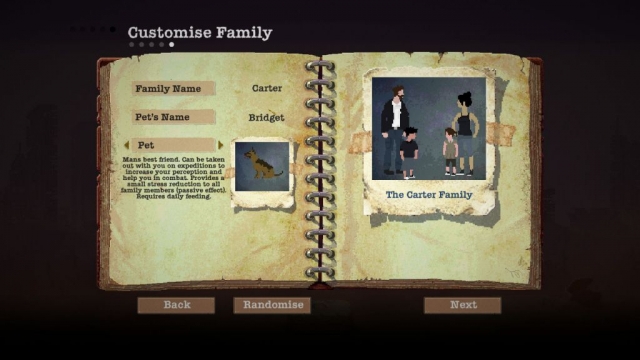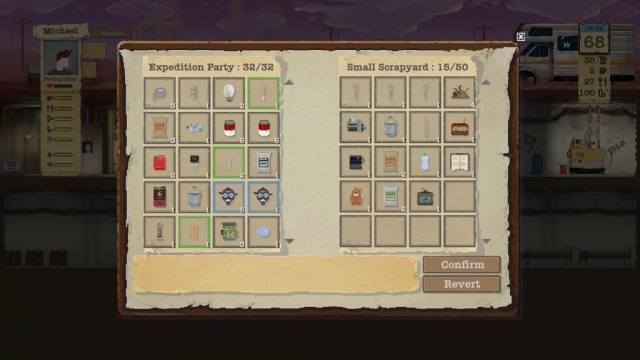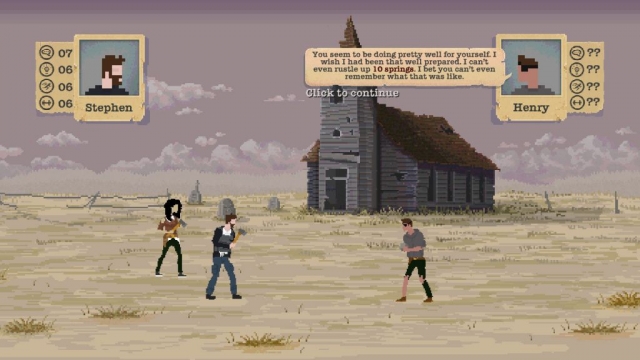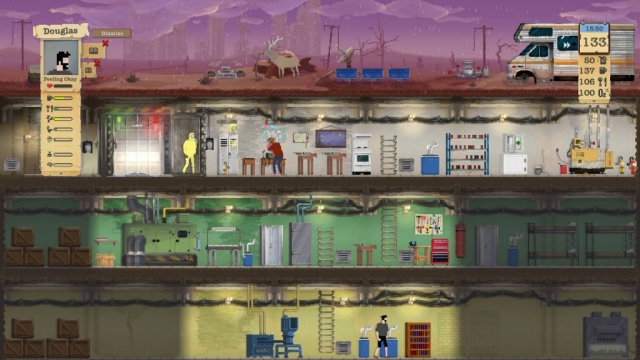Sheltered
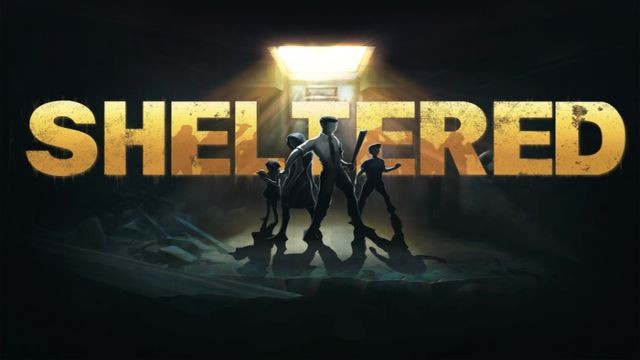
Sheltered is a new post-apocalyptic survival game. You start out with a family of four — plus a pet — and you take over an abandoned shelter when the bombs start falling. From there you have to build up the stats of your family, make your shelter more hospitable, and of course survive indefinitely. It’s easier said than done.
At the start of a new game of Sheltered, you have to create your family. That means you have to pick names, genders and appearances, which are all cosmetic, but you also have to pick a trait and a set of attributes for each character. Traits are things like Hygienic (the character doesn’t get as dirty), Proactive (the character moves faster), and Small Eater (the character requires less food). The attributes are Strength (melee damage), Dexterity (speed and accuracy), Intelligence (recruiting ability), Charisma (trading ability), and Perception (item discovery). Along with the above, characters also receive a random anti-trait (the opposite of one of the traits you can pick), which sometimes can be reversed. For example, if a character ends up with the Cowardice anti-trait, then you can reverse it to Courageous by forcing them participate in battles.
When you start playing the game, there are three things you have to concentrate on: keeping your survivors happy and healthy, scavenging for supplies, and building up your shelter. Let me start with health and happiness. Each character has a series of status bars for different categories, including sleep, hunger, thirst, and cleanliness. As those status bars fill up, you have to fulfill the need in some way. So if the character is hungry you have to send them to the pantry to eat something, if they’re sleepy you have to send them to a bed, and so forth.
At the start of the game when you only have four characters, it’s easy to micromanage these needs, but as your shelter grows in population (you can support up to 16 people), you’re allowed to automate characters, which means they’ll perform necessary activities on their own. If you don’t meet a character’s needs, then bad things happen. Dirty characters might come down with food poisoning when they eat, tired characters will refuse to do any work, and hungry characters will eventually die. But characters won’t ever leave your shelter unless you evict them.
To scavenge for supplies, you have to pick a route for one or two characters to follow, and then you have to send them on their way. There isn’t any sort of game element to scavenging; your scavengers just tell you what they’ve found, and you have to decide what you want them to keep. Characters start out only able to carry six stacks of items, which means you have to be really picky about what you take, but later you can equip them with backpacks so they can carry up to 18 items each. The locations that you visit, including houses, churches and scrapyards, never run out of supplies, so you can visit them as many times as you want.
The items you find while scavenging include necessities like food, water, and fuel (for your generator), and you can also find components like wood, metal, nails, plastic, transistors, and circuit boards. There are also some special items to find. You start out with a broken-down camper above your shelter, and if you can find the necessary parts for it, including tires, a battery, and a fan belt, then you can get it running again. You can also find tools that make constructing and repairing equipment easier in your shelter, and rare blueprints that allow you to build special, powerful items. Everything in the world is random, so you never know when and where you might find something.
While your characters are out scavenging, they sometimes run into animals or other people. With people, you can try to trade with them or recruit them to join you in your shelter, but sometimes the encounter leads to violence. Battles in the game are pretty simple. There aren’t any hex squares or anything for movement. Each character simply performs an action — usually to attack, but defend, subdue (aka knock out), and flee are also options — when it’s their turn, and then another character takes a turn, and so on.
Early in the game, battles can be tough, because your characters are wimpy and you don’t have any weapons better than lead pipes. But later once you’ve built up your characters’ stats, the battles get ridiculously easy. Even with a basic weapon like a hatchet, my scavengers would regularly kill off opponents in the first round before the opponents even got a chance to take their turn. Interestingly, I’ve seen screenshots of battles that look tough — with groups of up to four heavily armed human enemies — but I never saw anything like that in my game. My battles always consisted of a single animal or up to two (usually unarmed) humans. Of course, I’d always fight anyway, just because making a kill gives a character a bonus to their Strength and Dexterity.
While some of your characters are out scavenging, you have to leave at least one character inside your shelter to run it. All of the equipment in your shelter breaks down over time (even beds), and so your stay-at-home characters have to repair things as well as build things. They also need to deal with humans (usually traders) who come to visit you, as well as set snares on the surface so you can catch animals and supplement your food stores.
At the start of the game, you have about a level and a half of your shelter excavated, but once you’ve scavenged some wood and cement, you can expand your shelter to at least four levels. In this space you need to put beds, pantries (so you can store more food), storage boxes (so you can store more supplies), showers, toilets, and more. The items you can create are categorized into four tiers. You can construct the first tier items right away, but for the others you have to upgrade your workbench first, which of course requires lots of scavenged materials.
Along with traders and people who wish to join your shelter, you’re sometimes also visited by raiders who want to rob you. Oddly, despite combat being so easy on the surface, you’re not allowed to fight the raiders in your shelter. All you can do is upgrade your doors (to keep them outside), build traps (to damage them and slow them down), and create safe rooms (so your characters can hide). Apparently, raiders are only allowed to attack for a short period of time before leaving, so it’s just a matter of holding them off. I say “apparently” because I was only attacked once when I played, and the raiders gave up before they made it through my front door. This part of the game is both odd and unsatisfying.
Overall, Sheltered is fun — for a while. At the start of the game you have to make some tough choices about what to scavenge and what to build, and even with the right decisions you might not maintain enough food to survive. But as you build up your characters and improve your shelter, you become more powerful, but nothing in the world compensates to become more dangerous or to put any pressure on you. So after about 30 game days, all of the tension disappears, and the only thing left is to continue building new items in your shelter to see what they do, and to continue looking for camper parts and blueprints to see if anything interesting happens. There isn’t any way to “win” the game — you just survive for as long as you can — and so I ended up stopping around day 135 just because I was getting bored.
If you like survival games, then Sheltered is something you could try out. It’s simpler than the other such games I’ve played — like This War of Mine and Dead State — but it’s also more upbeat and casual, which might make it more appealing depending on what you’re looking for. It also has a lot of randomness, which helps its replay value. Right now Sheltered is the most fun when you’re just starting out, and it gets less fun as you go along, but its developers are still working on the game and accepting feedback, so maybe they’ll adjust the difficulty and add some end-game content in their upcoming patches. Regardless, Sheltered is fun enough right now to be worth its budget price.
Reviewed By: Steven Carter
Publisher: Team17
Rating: 76%
——————————————————————————–
This review is based on a digital copy of Sheltered for the PC provided by Team17.
 Game Over Online
Game Over Online